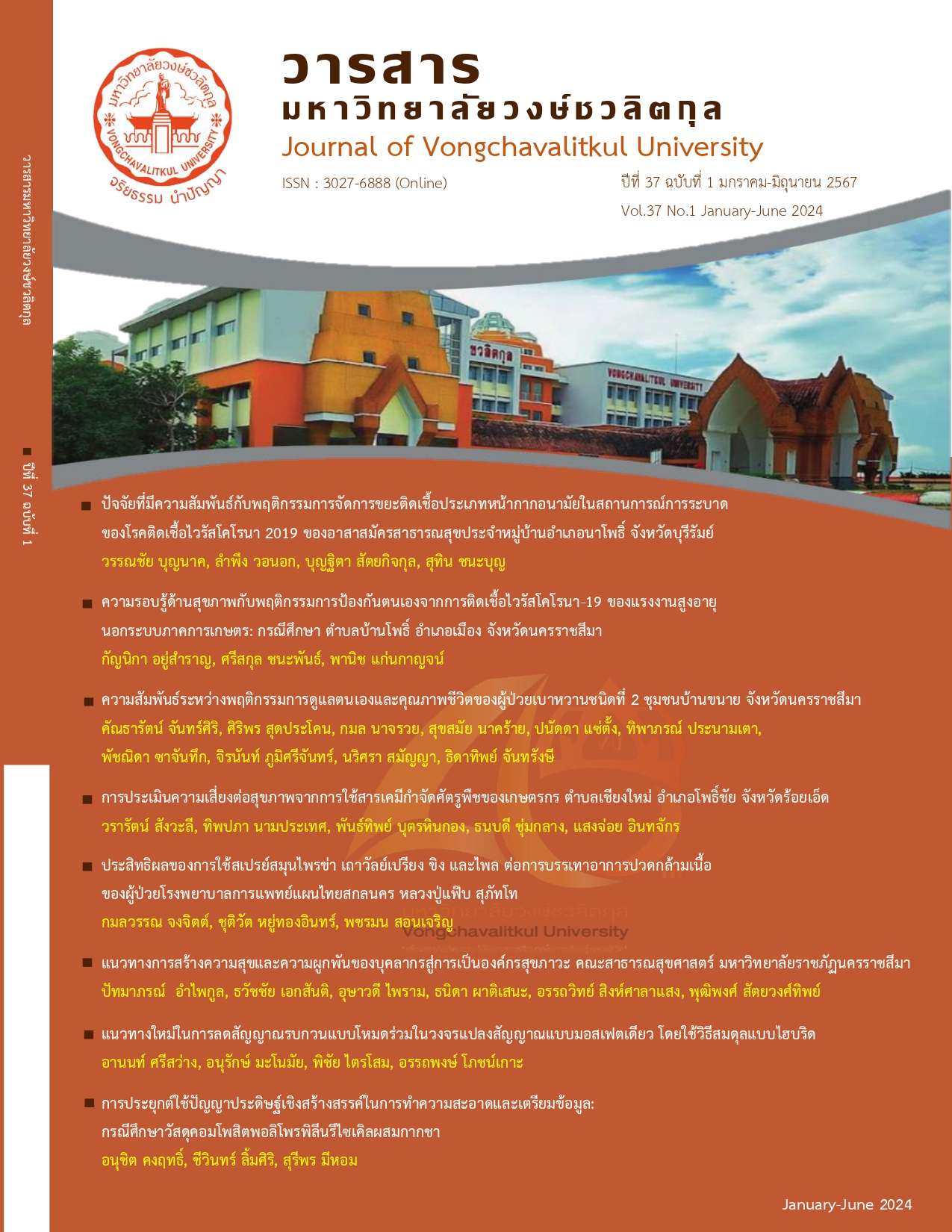Happiness and Engagement of Personnel Toward Being a Healthy Organization, Faculty of Public Health Nakhon Ratchasima Rajabhat University
Main Article Content
Abstract
Objectives: This research aimed to study eight indices of happiness and the promotion and engagement of happiness and engagement among personnel.
Methods: The sample group consisted of staff members of the Faculty of Public Health, working from October 2022 to September 2023. The tools used included questionnaires and interviews. Data were analysed using statistical software to present frequency, percentage, mean, and standard deviation. Additionally, qualitative content analysis was done by discourse analysis to interpret comments, which were then summarized and compiled comprehensively.
Results: The results of this research found that most of the respondents were female (17 persons, accounting for 68.00%). Most have worked for more than 10 years (56.00%). The majority of personnel hold academic positions (68.00%). The overall happiness index of the personnel is at a high level (x̄ = 3.71, S.D. = 0.67). When considering individual aspects, the top three aspects are: 1) eagerness to learn (x̄ = 4.26, S.D. = 0.58), 2) spiritual well-being (x̄ = 3.97, S.D. = 0.72), and 3) kindness (x̄ = 3.87, S.D. = 0.67). The lowest average aspect is financial well-being (x̄ = 3.30, S.D. = 0.66). The organizational commitment of personnel is also at a high level, with the highest mean aspect being psychological (x̄ = 3.87, S.D. = 0.67), followed by organizational retention (x̄ = 3.72, S.D. = 0.80). Comparing organizational commitment between male and female personnel shows no significant statistical difference. The strategies to enhance happiness and engagement among the staff should include promoting exercise, which might involve organizing workout sessions before and during meetings. And support their self-development through off-site study visits. Activities to reduce stress, such as religious ceremonies on holy days, should also be included. Furthermore, providing knowledge about saving money and encouraging staff to bring their family members to participate in faculty activities are recommended.
Article Details

This work is licensed under a Creative Commons Attribution-NonCommercial-NoDerivatives 4.0 International License.
References
กองบริหารงานบุคคล มหาวิทยาลัยราชภัฏนครราชสีมา. (2565). ข้อมูลบุคลากร มหาวิทยาลัยราชภัฏนครราชสีมา. สืบค้นเมื่อ 3 ตุลาคม 2565, จาก https://vpress.nrru.ac.th/personnel/index.php?option=com_content&view=article&id=85&Itemid=83
จรรยา ดาสา. (2552). ความสุขในที่ทำงาน (Happy workplace). สืบค้นเมื่อ 18 กันยายน 25565, จาก http://www.202.142.219.4/varticle/39142
ชวนพิศ นาเลี้ยง. (2558). ปัจจัยที่มีผลต่อความสุขจากการปฏิบัติงานของพนักงานสายสนับสนุน มหาวิทยาลัยศิลปากร. วิทยานิพนธ์บริหารธุรกิจมหาบัณฑิต สาขาวิชาการจัดการทั่วไป บัณฑิตวิทยาลัย มหาวิทยาลัยราชภัฏนครปฐม.
ชัยวัฒน์ ธนาคมชาคร. (2549). ปัจจัยที่ส่งผลต่อความผูกพันต่อองค์กรของพนักงานกลุ่มธุรกิจ สารสนเทศและการสื่อสาร: กรณีศึกษา บริษัท ซีเมนต์ จำกัด. การศึกษาค้นคว้าอิสระ บริหารธุรกิจมหาบัณฑิต สาขาวิชาบริหารธุรกิจ บัณฑิตวิทยาลัย มหาวิทยาลัยเกษตรศาสตร์.
นภัส จิตต์ธีรภาพ. (2554). ปัจจัยส่วนบุคคล ความสุขในการทำงาน และความผูกพันต่อองค์การของพนักงาน: กรณีศึกษาโรงงานอุตสาหกรรมอาหารแห่งหนึ่ง. วิทยานิพนธ์ศิลปศาสตรมหาบัณฑิต สาขาวิชาจิตวิทยาอุตสาหกรรมและองค์การ บัณฑิตวิทยาลัย มหาวิทยาลัยธรรมศาสตร์.
มหาวิทยาลัยราชภัฏกำแพงเพชร, ศูนย์บริการวิชาการองค์กรสุขภาวะภาคเหนือตอนล่าง. (2560). กล่องแห่งความสุข 8 ประการ - ( Happy 8 Menu). สืบค้น 28 พฤษภาคม 2567,จาก https://huso.kpru.ac.th/HappyWorkPlace/?page_id=121&lang=TH
ลลิดา พิมพการัง. (2552). ปัจจัยที่ผลักดันให้เกิดความผูกพันของพนักงานต่อองค์การในประเทศไทย. วิทยานิพนธ์บริหารธุรกิจมหาบัณฑิต มหาวิทยาลัยแม่ฟ้าหลวง.
ศิรินันท์ กิตติสุขสถิต, กาญจนา ตั้งชลทิพย์, สุภรต์ จรัสสิทธิ์, เฉลิมพล สายประเสริฐ, พอตา บุนยตีรณะ, วรรณภา อารีย์ และคณะ. (2555). คู่มือการวัดความสุขด้วยตนเอง HAPPINOMETER. นครปฐม: สถาบันวิจัยประชากรและสังคม มหาวิทยาลัยมหิดล.
ศิรินันท์ กิตติสุขสถิต และคณะ. (2565). รายงานการสำรวจคุณภาพชีวิต ความสุข ความผูกพันองค์กรของคนทำงาน (ในองค์กร) ระดับประเทศ พ.ศ. 2564. นครปฐม : สถาบันวิจัยประชากรและสังคม มหาวิทยาลัยมหิดล.
สำนักงานกองทุนสนับสนุนการสร้างเสริมสุขภาพ. (2552). คู่มือมาสร้างองค์กรแห่งความสุขกันเถอะ. กรุงเทพฯ: สำนักงานกองทุนสนับสนุนการสร้างเสริมสุขภาพ.
สำนักงานคณะกรรมการพัฒนาการเศรษฐกิจและสังคมแห่งชาติ. (2554). แผนพัฒนาเศรษฐกิจและสังคมแห่งชาติฉบับที่11 พ.ศ. 2555-2559. สืบค้นเมื่อ
พฤศจิกายน 2565, จาก http://www.nesdb.go.th/Default.aspx?tabid=395
Burton, J. (2010). WHO healthy workplace framework and model: Background and supporting literatureand practice: Word Health Organization. Retrieved 20 November 2015, form http://www.who.int/occupational_ health/healthy_workplace_framework.pdf
Martin, Angela J. Jones.Elizabeth S. and Callan, Victor J. (2005). The Role of Psychological Climate in Facilitating Employee Adjustment During Organizational Change. European Journal of Work and Organizational Psychology, 14(3), 263-289
Moorhead, G. & Griffin, R. W. (2010). Organizational behavior: Managing People and Organizations (9th ed.). China: South-Western CENGAGE Learning


